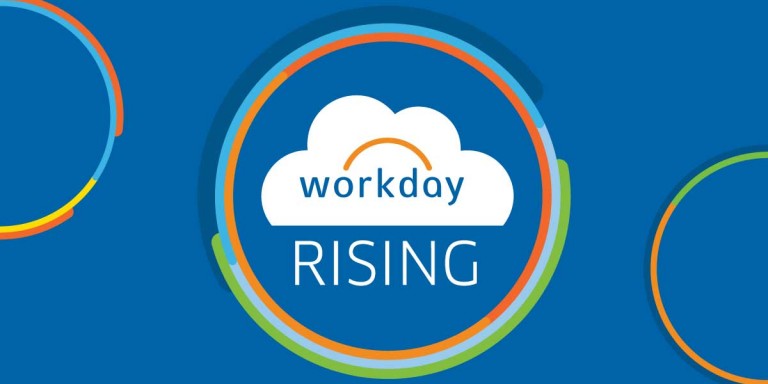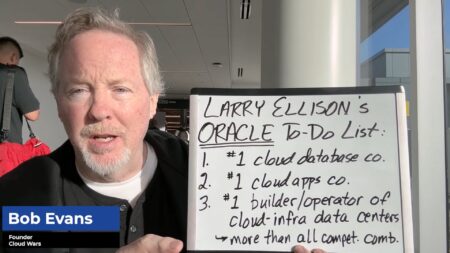Well on its way to a $4-billion annualized run rate, Workday is approaching that point where a large and successful company needs to address strategic questions in order to become a very large and very successful company.
The company’s annual customer conference, Workday Rising, opens today. So it’s the perfect time to take a look at 3 key questions Workday faces as it embarks on that journey toward someday becoming a $10-billion global powerhouse.
1. Can Workday’s leadership scale to those higher levels where the air’s much thinner? Where only truly exceptional executives can continue to succeed?
It’s been almost 15 years since Dave Duffield and Aneel Bhusri co-founded Workday. (This was in the aftermath of the bitterly contested takeover of their previous company, PeopleSoft, by Oracle.) From the outset, the co-founders carefully structured everything about the company—its stock structure, its culture, its product profile, its market position, its people, its commitment to advanced technology, its global expansion, and its ongoing obsession with customers. And it would be hard to pinpoint any mistakes that CEO Bhusri and chairman Duffield have made.
They’ve expanded aggressively but not to the point of upsetting all the key components outlined above. They’ve made acquisitions rarely but wisely. Their commitment to a single unified architecture is paying off handsomely in today’s data-driven world. And they’ve maintained or perhaps even improved their excellent relationships with customers.
Finally, in an industry filled with larger-than-life characters such as Salesforce’s Marc Benioff, Oracle’s Larry Ellison and SAP’s Bill McDermott, Bhusri remains exactly the sort of person and leader he was when I first met him almost 15 years ago. He is calmly assertive, quietly aggressive, passionately committed, and intensely intelligent.
Workday’s 10,000-plus employees would crawl over broken glass for Duffield and Bhusri—and I swear a lot of Workday’s customers would as well! I’ve never seen customers speak as glowingly about a tech vendor as do Workday’s. That might be the best indicator of great leaders being fully ready for the road ahead.
2. Is Workday’s product lineup broad enough and deep enough to take it from $1 billion per quarter to $2 billion per quarter?
According to Bhusri, Workday’s flagship HCM product suite has become the runaway favorite among the world’s largest companies. In my recent piece called Workday CEO: Oracle and SAP Can’t Match Us in Fortune 100, Bhusri said that half of the Fortune 500 have picked Workday for HCM. And, 35 of those 50 are in production. That status gives Workday the ability to showcase live, referenceable customers in ways that he says Oracle and SAP just can’t match. From that recent article:
During Workday’s fiscal Q2 earnings call last week, Bhusri was asked if Workday’s gaining ground among large customers that had bought early versions of cloud HCM products from Oracle and SAP and have since decided to replace them.
“If you look at the Fortune 500, candidly neither of our large competitors have real proof-points over 100,000 employees or even over 50,000 employees that are in production,” Bhusri said.
“But a huge part of our success has been not just winning the customer, but more importantly getting them into production and having them be happy.”
Bhusri said that about 50% of the Fortune 100 have subscribed to Workday’s cloud HCM services. And that of those 50, 35 are already live.
“So that’s a huge advantage,” said Bhusri.
On top of that, revenue for Workday Financials continue to grow at least 50% per quarter. And the attach-rate for the two products is climbing, the company says.
In the white-hot category of enterprise planning, Bhusri said its Adaptive Insights unit, acquired about 16 months ago, has been a huge success. (For more on Adaptive Insights, check out Workday’s Secret Weapon Has “Phenomenal” First Year.)
Finally, on an earnings call with analysts several months ago, Bhusri offered a provocative answer—some might call it “oracular,” but I won’t do that—when asked if Workday might expand more deeply into ERP with supply-chain applications. Here’s how I laid out Bhusri’s reply in a piece called Workday’s Path to a $1-Billion Quarter: 10 Key Insights:
An Expanding and Integrated Suite of Products.
Building off his earlier point about how Workday’s broader product line is taking some of the pressure off of the HCM flagship, Bhusri endorsed the suite concept. He said, “I think it’s still early, but if a customer has Workday HR and Planning—more than just one Workday product in the account—then I think it bodes well for our Financials. Because then the account has the chances to default to a Workday platform.”
Later in the Q&A, Bhusri gave a classic hedged answer when asked about the possibility of a further expansion of the product line into the supply-chain space: “I would say it’s on the radar but I wouldn’t say that we are going to be announcing anything imminently. That’s a big undertaking, and we still have more work to do to really establish ourselves as leaders outside of HR. We want that same leadership position for Financials and for Planning…
“With Prism Analytics, we saw 70% growth this past quarter, so I don’t feel the need for another growth engine at this point. And frankly, I think it would be a distraction. We have a lot of work to do on the product side, especially as we take all the products into the world of machine learning. But you know, I would ask that question every year. And sometime you might get a different answer.”
3. Can Workday continue to thrive against competitors that are 8 or 10 times larger than it is?
Certainly, Bhusri’s comment in #2 above about Workday HCM’s dominance among the world’s largest corporations says a great deal about Workday’s ability to go head-to-head in that portion of the market. But in ERP and Financials, it’s going to be a tougher fight. Larry Ellison said recently that Oracle now has 31,000 customers for its SaaS apps, with the vast majority of those in cloud ERP across both Oracle and NetSuite. So: can Bhusri and team find a way to fully exploit that tendency among customers to pick a Financials vendor based on success with its HCM products?
Workday’s analytics solution, Prism, grew 70% in the company’s previous quarter. But it‘s facing enormous competition from not just Oracle and SAP but also Microsoft, Salesforce and others. Can Workday find ways to differentiate its offerings and use its “One” architecture plan to convince its HCM and Financials customers that Prism’s the best way to go?
Most of all, the answer will depend on Bhusri’s ability to, in many respects, ignore the question itself. After all, why should he worry about the competitors and what they’re doing or might be doing?
After all, for 15 years, Workday has shown that an obsession with customer success and great customer experiences is the one and only way to go.
Cloud Wars
Top 10 Rankings — Oct. 14, 2019
| 1. Microsoft — Q1 cloud revenue will top SFDC, SAP, Oracle & Google *combined* |
| 2. Amazon — AWS Q2 revenue jumps 37% to $8.38B, cites broad innovation in ML |
| 3. Salesforce —Is Benioff planning to switch more databases from Oracle to AWS? |
| 4. SAP —McDermott steps down for new adventures after posting great Q3 numbers |
| 5. Oracle — Ellison: Autonomous DB growth “so extraordinary, we’re not forecasting” |
| 6. Google — Q2 cloud rev. tops $2B; Kurian’s customer focus leads jump from #7 to #6 |
| 7. IBM — Q3 numbers will hint at Rometty’s $33-billion bet on Red Hat |
| 8. Workday — CEO Aneel Bhusri says Oracle, SAP can’t match it in Fortune 100 mkt. |
| 9. Accenture — Up from #10 on ties w/ MSFT AWS GOOG; $9B cloud biz up 23% in ‘18 |
| 10. ServiceNow — Donahoe looks to Microsoft & mobile to drive next growth wave |
Disclosure: at the time of this writing, Workday was a client of Cloud Wars Media LLC.
Subscribe to the Cloud Wars Newsletter for in-depth analysis of the major cloud vendors from the perspective of business customers. It’s free, it’s exclusive, and it’s great!








